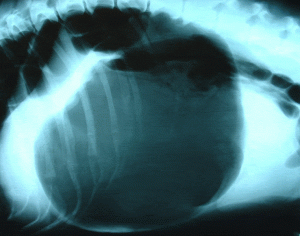Preventing Dog Bloat in Chicago with Gastropexy
 Prophylactic gastropexy is performed at Metropolitan Veterinary Center in Chicago to help prevent gastric dilatation volvulus (GDV) or “Bloat” with rotation of the stomach. It is currently recommended by many veterinary surgeons for breeds at risk for development of the condition or in dogs that have relatives that have been related to others that have had this condition. A patient with GDV requires expensive emergency treatment and surgery, and is fatal in 40% of affected dogs, depending on the health of the stomach at the time of surgery.
Prophylactic gastropexy is performed at Metropolitan Veterinary Center in Chicago to help prevent gastric dilatation volvulus (GDV) or “Bloat” with rotation of the stomach. It is currently recommended by many veterinary surgeons for breeds at risk for development of the condition or in dogs that have relatives that have been related to others that have had this condition. A patient with GDV requires expensive emergency treatment and surgery, and is fatal in 40% of affected dogs, depending on the health of the stomach at the time of surgery.
Breeds (and these breed mixes) at highest risk for GDV have conformations that demonstrate deep chests including but not limited to: Great Dane, Weimaraner, St. Bernard, Gordon Setter, Irish Setter, Standard Poodle, Irish Wolfhound, German Shepherd, and Doberman Pinscher.
Gastropexy is a surgical procedure to permanently attach the stomach to the inside of the body wall. It is important to understand that gastropexy does not prevent future episodes of gastric bloat, but prevents the volvulus which is the life threatening twisting of the stomach. Several studies have shown NO adverse effects from prophylactic gastropexy in otherwise healthy adult dogs.
In a recent study of prophylactic gastropexy in large breed dogs with a history of recurrent dilatation or other GI motility disease, 80% showed improvement of signs and none developed GDV during 1 year of follow-up. Prophylactic gastropexy is strongly recommended in dogs with a history of gastric dilatation/bloating (to prevent progression to GDV), or in those with a first degree relative affected by GDV. Prophylactic gastropexy is often considered in any dog considered a high risk breed, even if there have been no clinical signs or any known family members affected by GDV.
Middle aged to older dogs are most often affected by GDV. Each year that a dog considered a high risk breed (or a mix breed dog containing high risk breeds) is alive, their risk for GDV increases dramatically. GDV is invariably fatal unless treated with emergency surgery, and even with the most advanced treatment some dogs do not survive. Because of the costs and risks associated with treatment for GDV, prophylactic gastropexy is often an attractive option in a young, healthy dog of a high risk breed or high risk breed mixes.
Prophylactic gastropexy is often performed at the time of routine spay or neuter in young dogs.
We are happy to answer any questions you may have about the procedure and to schedule an appointment.
Prophylactic Gastropexy and Its Advantages
Prophylactic gastropexy is a surgical procedure to help prevent gastric dilatation volvulus (GDV) or “Bloat” in breeds at risk of development or dogs that have relatives that have had this condition. Breeds at highest risk for GDV have body structures that demonstrate deep chests such as the Great Dane, Weimaraner, St. Bernard, Gordon Setter, Irish Setter, Standard Poodle, Irish Wolfhound, German Shepherd, and Doberman Pinscher.
Gastropexy is a surgical procedure performed to permanently attach the stomach to the inside of the body wall. Gastropexy does not necessarily prevent the dilatation or bloating of the stomach, but rather the “flipping” of the stomach on its axis in approximately 95% of dogs. When the stomach “flips”, it effectively shuts off its blood supply causing death of stomach tissue. Several studies have shown that there are no adverse effects from prophylactic gastropexy in otherwise healthy adult dogs
GDV most often affects middle-aged to older dogs. Each year that a dog of high?risk breed is alive, their risk for GDV increases dramatically.
GDV is fatal unless treated with emergency surgery, and even with the most advanced treatment some dogs will not survive. Due to the costs and risks associated with treatment for GDV, prophylactic gastropexy is often an attractive option in a young, healthy dog of a high?risk breed.
Prophylactic gastropexy is often performed at the time of routine “spay” in young female dogs, though the incision is substantially longer than for the spay alone. It can also be performed in young male dogs at the time of neuter.
